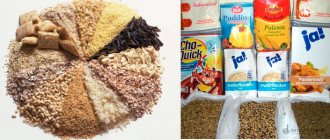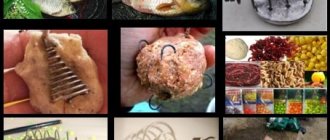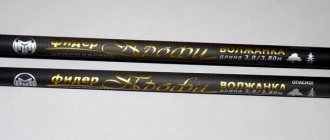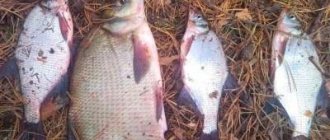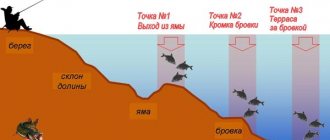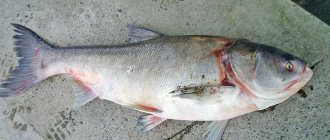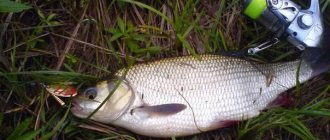Benefits of Salapin porridge
The key property of salapinka is that, in addition to finely dispersed components, one of the components is pearl barley, which is important for attracting large fish, since small ones are not able to swallow it.
Ready-made bait mixtures generally have a finely dispersed structure if they have an impressive odor. When it comes into contact with water, a cloud of turbidity appears, which arouses the fish's interest. But after it dissipates, the fish leaves the fishing spot if it doesn’t like the bait.
Salapin porridge performs the main tasks of bait, such as attracting fish and keeping it at the casting point, one hundred percent. In addition, it is able to provide long-term uninterrupted feeding, due to the fact that large components do not disintegrate immediately.
Other advantages of such porridge in comparison with ready-made bait:
- full control over the quality and freshness of ingredients;
- ease of preparation and availability of ingredients;
- ease of use, as you can take bait in any quantity.
Advantages of homemade baits
When choosing between mixture and homemade bait, you need to turn to your own preferences. By choosing a ready-made mixture, the fisherman will spend less time on the process of preparing complementary foods, but the result will be lower. Ready-made mixtures consist mainly of dry ingredients, such as feed, which are less attractive to fish than freshly prepared food.
Making the mixture yourself allows you to control the quantity and quality of ingredients, the properties of the final product, consistency and other parameters. In addition, many fishermen note that they receive incomparably greater pleasure from the process of making their own mixture.
Ingredients of classic Salapin porridge
You will need simple and inexpensive ingredients that are sold in any grocery store:
- pearl barley – 1 part;
- barley groats – 2 parts;
- corn grits – 3 parts;
- millet – 2 parts;
- water – 9 parts;
- vanilla sugar or vanillin – 2-5 grams;
- refined vegetable oil 1-3 tablespoons.
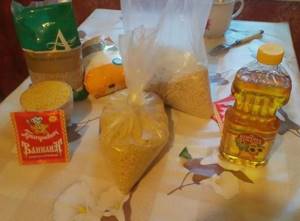
It is recommended to use homemade oil, which can be purchased in the market. It has a distinct smell of natural origin. The amount of butter and vanillin required is determined depending on the volume of the resulting porridge.
Principles of cooking porridge
Nowadays, purchasing fishing bait with a narrow focus on a certain type of fish is quite commonplace, making it much easier for the angler to prepare for fishing. But the effectiveness of these mixtures does not always contribute to achieving positive results. To a large extent, baits are prepared for standard fishing conditions without any special features that can arouse a sustained interest in the fish in the food. Experienced bream fishermen pay special attention to baits, not trusting universal store-bought mixes, and for fishing trips they prepare a special porridge for catching bream. The homemade product has a number of fundamental differences from standard feeds, to which we will draw the reader’s special attention, delving into their essence in more detail.
What should the smell of bait be like?
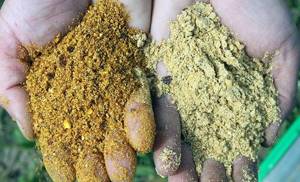
Porridge for catching bream on a feeder should have a pleasant, but not intrusive and unsaturated aroma. Throughout the year, depending on the water temperature, the taste preferences of bream change, and consequently, the types of attractants used to flavor the brew undergo changes. The intensity of the odor in warm waters increases, negating the presence of the flavor in cold water, where the attractiveness of the product is determined by the natural odors of the main ingredients included in the food recipe.
Taste
Most species of carp fish have a pronounced sweet tooth, of which bream is no exception. The taste of the boiled mixture should have a distinct sweet component, which is achieved by including honey, molasses in cooking recipes or by sweetening the bait with portions of regular sugar. In addition to the function of a sweetener, components such as honey and molasses play the role of a strong attractant, so their use is controlled by a strict dosage, eliminating an excess of aroma that is unnecessary in intensity.
Turbidity in water plays an important role
Of particular interest to schools of bream is the cloudy trail emanating from a charged bait device. Therefore, you need to cook porridge for bream with the necessary additives that help create a distinct turbidity when dissolved in water. Turbid clouds, together with sweet aromas, spreading with the current, attract large fish to the fishing spot even from long distances, thereby increasing not only the stability of the bite, but also the likelihood of catching trophy specimens.

Viscosity
Depending on the strength of the current, the composition of the bait varies in density and viscosity of its consistency. Bream porridge should not immediately crumble when it gets into the water, but should, upon reaching the bottom, be washed out of the feeder gradually, in equal portions. In this case, the time intervals for porridge erosion should be short, from 7 to 10 minutes, but all these parameters, and in particular the viscosity of the brew, directly depend on the intensity of the flow.
Color
Often, bream fishing occurs at significant depths, where the color design of the composition fades into the background, having little effect on increasing the level of attractiveness of the food. It is generally accepted that a promising composition should be light in color. Whitish, yellow and light gray shades are more clearly visible on the bottom, but at the same time do not cause suspicion in the fish due to the naturalness of the color. If the food has to be darkened, then adding soil taken directly from the shore of the reservoir to the brew prepared for serving is suitable for this purpose. This technique gives the porridge a color similar to the bottom of the fished reservoir.
Tandem of complementary foods and attachments
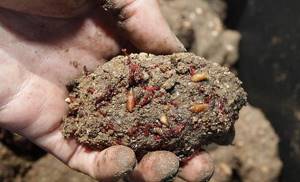
An important factor in the successful operation of the bait is the presence in its formulation of such a component as the bait used in fishing. Only for feed additives are smaller parts of the bait used, for example, crushing peas, kneading sweet corn or cutting a worm into pieces with scissors. They put a whole bait on the hook that is much more attractive in appearance. Cunning contributes to the reliability of the bite, because the fish competing in the school for food items tries to quickly suck up a larger piece, thereby guaranteed to get hooked.
Preparation
To properly prepare Salapin porridge, it is important to adhere to the following sequence of actions:
- Place a pan of water on the fire and heat to a boil;
- add pearl barley porridge, reduce heat to low and close the lid;
- cook for 20-30 minutes until half cooked, stirring from time to time and skimming off the foam. A sign of readiness is the appearance of a light rim along the edges of the grains;
- add millet, mix everything and continue cooking over low heat;
- after 5 minutes add vanilla sugar and pour in a little sunflower oil;
- turn off the heat at the moment when the millet has completely absorbed all the water and begins to boil;
- close the pan with a lid and leave the porridge to simmer for 30-40 minutes until characteristic wells appear;
- add corn and barley grits and mix thoroughly. If the pan is spacious, then it is easier to stir in it, otherwise it is better to use a separate container, such as a basin;
- During the time before fishing, the grains will swell a little.
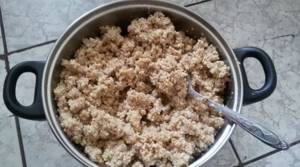
Selecting ingredients for cooking
Both for feeder and bottom fishing from a boat, from the shore and in strong currents, complementary foods are created using the same components. The difference is usually only the viscosity and density of the mix. All ingredients are divided into subcategories, according to the role they play in complementary foods. By knowing and arranging them together, you can get a unique mixture that helps to effectively attract fish. At the same time, the cost of such complementary feeding will be extremely low.
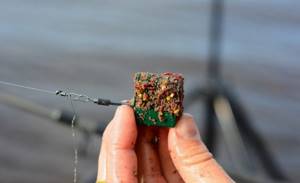
The basis
The bait is based on ingredients with a fine texture. Often these are crushed cereal grains and breadcrumbs. You can also use ready-made mixed feed, cookies with a sweet taste, flax, rapeseed, sunflower, hemp, and pumpkin seeds twisted in a meat grinder or in a blender as a base.
Important! The base volume should be 60% of the total mix.
Oatmeal flakes will also work here. When in contact with water, the base mixture should create turbidity and thereby attract bream. (This has already been said above)
Flavors
Most bream bait recipes use flavorings. With them you can count on attracting a large number of fish. To add flavor to the porridge, products of natural plant origin should be used. This could be spices, fruit and vegetable juice. It is impossible to unambiguously predict which particular aroma will attract fish in a particular body of water at a particular time - it all depends on tests and experiments on site.
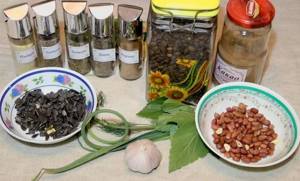
Boiled mixtures are usually flavored with anise, vanillin, cinnamon, cocoa, coriander, cumin, dill, fennel, garlic, fish oil, and vegetable oil (especially in cold weather). You can also purchase strawberry, banana, and apricot concentrates for flavoring.
Did you know? In reservoirs with stagnant water, bream sometimes live up to 23 years. While in conditions of fast flow, individuals of this species live no longer than 10 years.
Fillers
Fillers include heat-treated products with the addition of bait. These ingredients make the food more nutritious and high in calories. It can be boiled peas, corn, pasta, eggs, wheat, pearl barley. As bait (depending on what will act as bait on the hook), maggots, cut worms, food bloodworms, canned peas or corn are used, which are slightly kneaded.
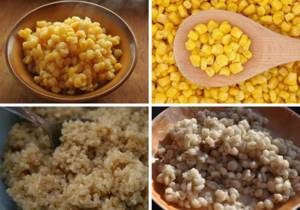
For consistency
The consistency of the bait should be viscous, provide turbidity and be evenly washed out of the feeder. The stronger the current, the denser the bait ball should be. To do this, add sugar, wheat flour, clay, bread crumb, dough, crushed oatmeal. As a loosening component for too thick masses, you can use sunflower cake, which at the same time serves as an attractant for fish.
Also check out the features of creating your own bait for catching carp and carp.
Dyes
Natural ingredients are used as dyes. For this purpose, clay, soil, and crushed crackers are used . However, the color of the bait usually does not play a decisive role.
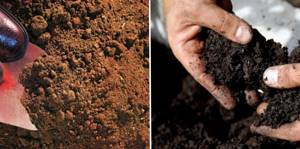
Additional components and flavors
The classic recipe for Salapin porridge is described above. But sometimes it is useful to change the recipe a little, because you need to feed the fish with what you catch. That is, if peas or wheat are used as bait, then they will also be useful for porridge. It’s just important not to overdo it. The percentage of auxiliary components should not be more than ten of the total volume of porridge. Also, do not forget that the groundbait should not be more attractive than the bait.
As a flavoring agent, vanilla can be replaced with other strong-smelling additives. In this case, you should choose the aroma that is able to attract the object of fishing and corresponds to the time of year.
In spring and late autumn, flavorings with the smell of anise, garlic, dill work excellently, and it is also useful to add bloodworms or finely chopped worms.
In the summer heat, the fish prefers sweet smells such as honey, strawberry, peach, banana or caramel.
Often, clay is taken as an auxiliary component from the reservoir in which fishing is carried out. As a result, the saturation of the fish will occur more slowly and the likelihood of catching a large specimen will increase.
Porridge made according to the described recipe can be used either separately or in combination with purchased bait.
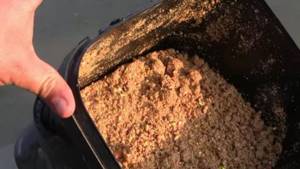
Making your own bait
Here are several popular recipes that will help you properly feed bream at different times of the year and in different bodies of water.
Recipe No. 1. Summer, closed reservoir without current
For such conditions the following composition is suitable:
- 300 grams of breadcrumbs;
- ground (makukha) or roasted sunflower seeds – 0.2 kilograms;
- bran and boiled millet – 300 grams of each product;
- dry crushed coriander - about two-thirds of a teaspoon;
- dry crushed clay. It is better to prepare more of it and gradually add it while wetting to achieve the desired consistency of the composition.
Recipe No. 2. Summer, fishing on a river with a pronounced current
In this case, the porridge will have slightly different ingredients:
- Sunflower cake – 0.2 kilograms;
- breadcrumbs (or ground yourself) – 100 grams;
- sprouted green peas (if it’s difficult to get them, you can use fresh ones) – 200 grams;
- steamed oatmeal – 0.2 kilograms;
- 3 teaspoons ground coriander;
- standard packet of vanilla sugar;
- fine clay or soil of the same consistency directly from the fishing spot.
Recipe No. 3. Spring
At this time of year, it is imperative to include ingredients of animal origin.
One of the popular options:
- boiled millet – 100 grams;
- sunflower cake – 100 grams;
- bran (it is advisable to find rye bran) – 100 grams;
- bloodworm - about three matchboxes;
- clay , can be mixed with sand if the bottom of the reservoir has a sandy base. If there is a thick layer of silt, it is better to add soil from the shore.
Recipe No. 4. Autumn, pond with current
During this period, the fish fatten up their reserves for the winter, so complementary foods include nutritious animal components:
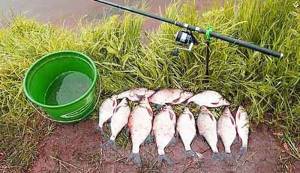
- fresh pork lard, cut into cubes with a side of about 5 millimeters - 50 grams;
- ground wheat crackers (you can use store-bought breadcrumbs) – 100 grams;
- any cake and bran - 100 grams of each product;
- boiled pearl barley (more expensive option - rice) - 100 grams;
- maggot, bloodworm, worm chopped into appropriate pieces - two matchboxes;
- a teaspoon of coriander;
- clay or soil for viscosity, the amount is selected experimentally.
In all of the above recipes, coriander is used as a flavoring, but you can use other options, which we will discuss below. The preparation method is also simple - the ingredients are mixed and moistened.
Where does Salapin porridge work?
Salapin porridge is equally effective both on the current and in ponds, lakes and reservoirs. For fishing in still water, the bait should be made more crumbly, and for the river - more viscous, so that it does not erode too quickly.
The consistency of the porridge can be changed on the shore of a pond without any problems. To do this, add water to the too crumbly bait or mix in steamed rolled oats, and in the opposite situation, add egg or corn flour. Naturally, after changing the composition of the bait, it is necessary to mix it.
The color of the porridge often significantly affects the fishing result. The resulting porridge can contrast greatly with the dark bottom. This problem can be solved using food coloring.
Main ingredients and recipes for different conditions
Porridge for both feeder fishing and ring fishing for bream is prepared using the same constant ingredients. Ingredients are divided into categories depending on their functions in the feed. There is a strict number of categories, which we will focus on in more detail.
The basis or base of feeding includes in its list a small fraction, most often consisting of ground cereal grains, breadcrumbs, mixed feed, sweet biscuits, crushed flax grains, rapeseed, sunflower, hemp and pumpkin; this category includes oatmeal or more familiar to the average person Hercules.
Important! The volume of the base is about 60% of the mixture.
When it gets into the water, the fraction must generate dust, which is what attracts bream.
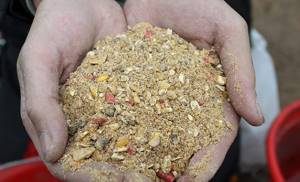
The category of fillers consists of thermally processed products and crushed bait. Filler is a substance that adds nutritional value and calorie content to complementary foods. Steamed peas and corn, boiled pasta, cereals, sunflower seeds cut into a meat grinder, various types of feed, including fish, are considered the main fillers. Mixed baits are filled with chopped worms, maggots, bloodworms, crushed boiled or canned sweet peas and corn. The connecting link of the ingredients is sugar, wheat flour, pea puree and clay.
The category for dregs contains components such as milk powder, semolina, baker's dough, and white wheat bread crumb. They try to use natural and natural products as dyes. Clay, garden soil, and ground crackers are suitable for these purposes. Fishermen, by combining the presented categories of ingredients, receive a cheap bait product that is effective and has all the properties required to attract bream.
How to cook porridge for bream in a feeder
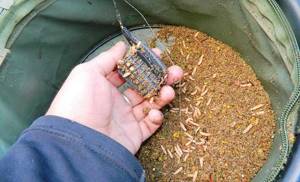
In practice, bream workers use many different, but similar in operating principle, mixtures. Each fisherman, based on his personal experience, refines recipes to suit narrower specifics and fishing conditions, and the taste preferences of fish vary from reservoir to reservoir, which must be taken into account when preparing a mixed fish. The most famous and popular recipe is Salapinka porridge for bream feeder.
Formulations with peas and baits with nuances of additives that stimulate biting based on certain weather conditions and seasons of the year also deserve no less attention and will not become a useless burden in the fisherman’s knowledge base. We offer the reader a number of simple porridge recipes that can be prepared at home without much expense of money and time.
Salapinskaya porridge for bream feeder
Salapin porridge for feeder is a universal recipe for fishing from a boat and the shore both on currents and in weakly flowing reservoirs. The brew is prepared using pearl barley, which is boiled over low heat until completely swollen. For two glasses of cereal you will need three glasses of water. After cooking the pearl barley, add a glass of millet, a packet of vanillin and a couple of tablespoons of vegetable oil to the porridge. After stirring the mixture, cook the mixture until the liquid has completely evaporated, then cover with a lid and let it brew for one hour. To the swollen porridge, all that remains is to add a glass of corn and barley flour and the same amount of semolina.
Pea porridge for fishing
The recipe is applicable especially for fishing on a feeder with open types of feeders. It is recommended to use foam balls as bait. To implement the recipe, take 250 grams of peas, which are boiled until crumbly, a glass of millet, a tablespoon of granulated sugar, a teaspoon of baking soda. The components are thoroughly mixed together, and at the last stage of cooking, the attractant required to taste is added.
For spring fishing
The secret to the success of spring bream fishing lies in the use of a large volume of animal components in the bait mash. A simple spring boiled mix is prepared according to the following algorithm: breadcrumbs are taken as a basis - 2 cups, to which boiled millet is added - 1 cup, additionally cut with a meat grinder, sunflower cake - 1 cup, bloodworm - 1 cup and a couple of teaspoons of coriander for a lasting smell.
Bait for fishing in hot weather
For some fishermen, the recipe will seem slightly exotic, but practice shows its high degree of effectiveness in the summer, during periods of hot weather. For one part of millet porridge, take the same volume of fried sunflower bran and a third of the volume of fresh or frozen bloodworms. Exotic, and the highlight of the food is a tenth of crushed young shoots of strong-smelling horsetail. The ingredients are mixed, achieving the desired viscosity by adding soil or sand.
Preparing bream porridge for autumn
An autumn recipe for bream porridge consists of rice filler, boiled until fully cooked in water, breadcrumbs, rye bran and chopped raw sunflower seeds. The components are taken in equal parts and thoroughly mixed together. Finely chopped fresh lard is added to the porridge, 1/2 of it is enough, and vanilla or coriander is enough for a barely noticeable smell. The consistency required for plasticity is adjusted by adding clay.
Porridge for catching bream - a recipe for long casting
Fishermen have developed recipes for porridges for long-distance fishing. The mixtures are characterized by low specific density with large volumes and low viscosity with low flowability. Breadcrumbs and pumpkin seed cake are added to the cooked oatmeal in equal parts. A third of the volume of pureed raw peanuts and the same volume of canned or live maggots are added to the mixture. The plasticity of the mix is regulated by rye bran and the addition of the required volumes of water.
Bait methods
Salapinka works when fishing with a feeder, float rod and spring. When fishing on a feeder, the feeder is filled with porridge before casting. Complete washing of the porridge on the river occurs in a few minutes, depending on its consistency and the size of the feeder cell. The time between casts should not exceed five minutes, since feeder fishing is characterized by frequent casts.
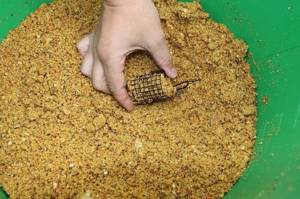
It is advisable to use Salapin porridge when fishing with a spring in reservoirs with standing water or low currents. In a good current it washes out very quickly. By squeezing the feeder harder, you can slightly increase this time.
Fishing with a fly rod involves throwing compressed balls of porridge at the fishing point.
Despite the cheapness of Salapin porridge, the fish reacts very well to it, it is only important to prepare it correctly!
- Bait for crucian carp
- Bait for winter fishing
- Do-it-yourself bait for tench
- How to store bait?
Recommendations for quality complementary feeding
We invite you to familiarize yourself with tips on high-quality complementary feeding of bream from experienced fishermen:
- For feeder fishing, feeders weighing 90 g and above are used. According to the landmark, they are thrown into the same place. As soon as the feeder sinks to the bottom of the reservoir, the tackle is placed on a special stand. The fishing line does not wind up.
- When fishing with a float rod, it is better to form the porridge into balls. For viscosity, it is recommended to use clay, soil from the same reservoir where fishing is carried out. Several balls of food are thrown into one place. After which, after two to three minutes, you can cast the rod with bait. If the bite subsides, then the bait for the fish is resumed.
- In winter, it is advisable to use a cone-shaped feeder. Its main advantage is that it opens when you touch the bottom. Thanks to this, all the porridge is neatly poured out in one place, and the bream concentrates on the desired area. The price of the purchased product is quite affordable.
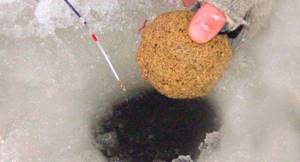
One form of complementary feeding is throwing porridge balls onto the bottom of the reservoir. A convenient way for fishing on lakes and ponds where there is no current. For fishing on rivers and reservoirs, it is recommended to purchase or make special feeders by hand.
In what bodies of water can porridge be used?
Salapin porridge is successfully used both in still water and in currents. For reservoirs with standing water, the mixture should be moderately crumbly so that after hitting the water it is distributed over a small volume. Over time, the bait should be slowly distributed around the feeder.
The color of the food spot is made as natural as possible, no different from its surroundings. For these purposes, you can add very little food coloring to the mixture so as not to get the opposite effect. The ideal option is to use gley or sludge from a pond. Bottom sludge will also help bring the consistency of the mixture to the desired level if the amount of added flour, corn chaff, flakes or other binding components is not enough. They are not always on hand in sufficient quantities. A little dry whole or crushed grain or sand will help make the mixture more crumbly.
For rivers, the bait is made thicker, packed more tightly into the feeder, and glue, clay or silt from the bottom of the reservoir is added to it. Another solution is to use a feeder with a finer mesh.
Consistency is checked in two ways:
- the moderately crumbly mixture is squeezed with your fingers, it should stick together, form a lump, and when pressed hard, it should crumble;
- the ball is lowered into the water near the shore and observed: it slowly dissolves, and the components of the bait fill the surrounding volume.
